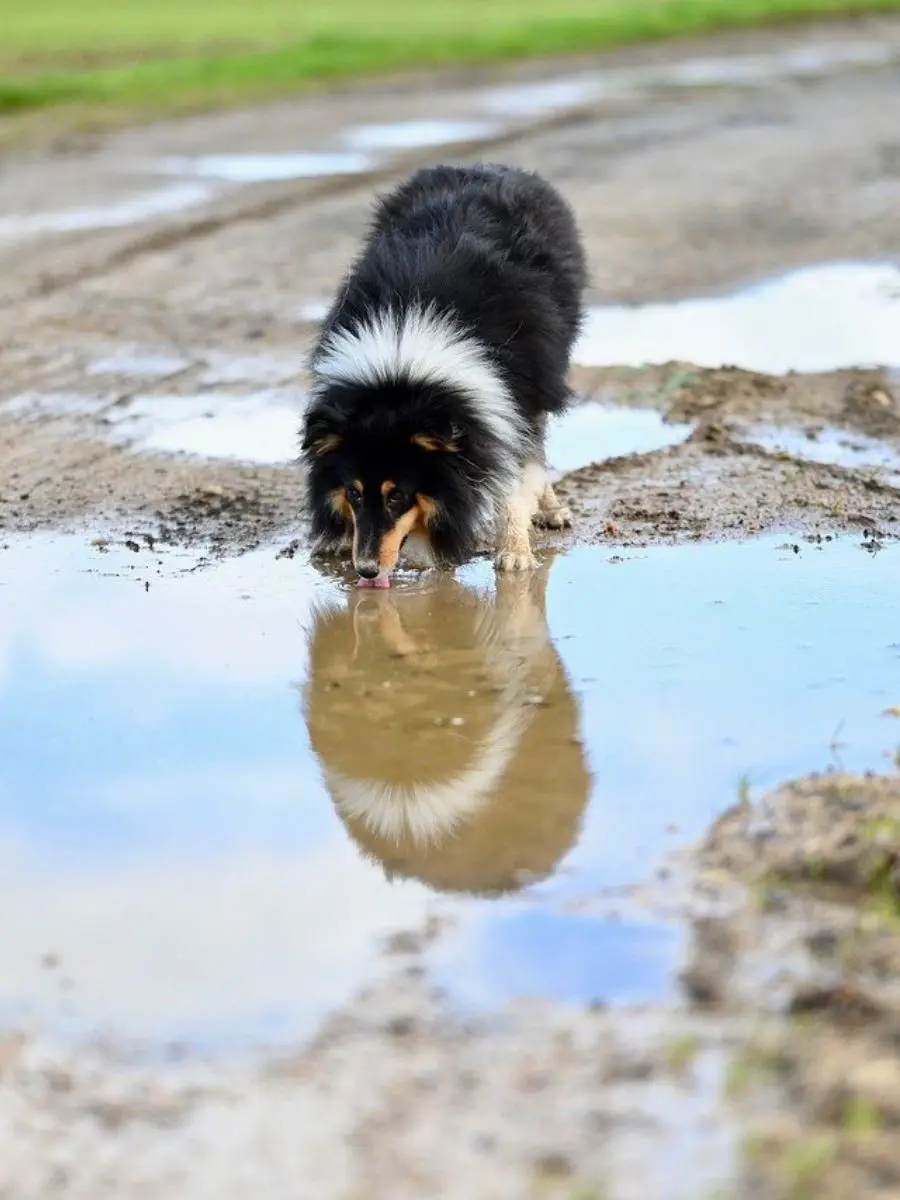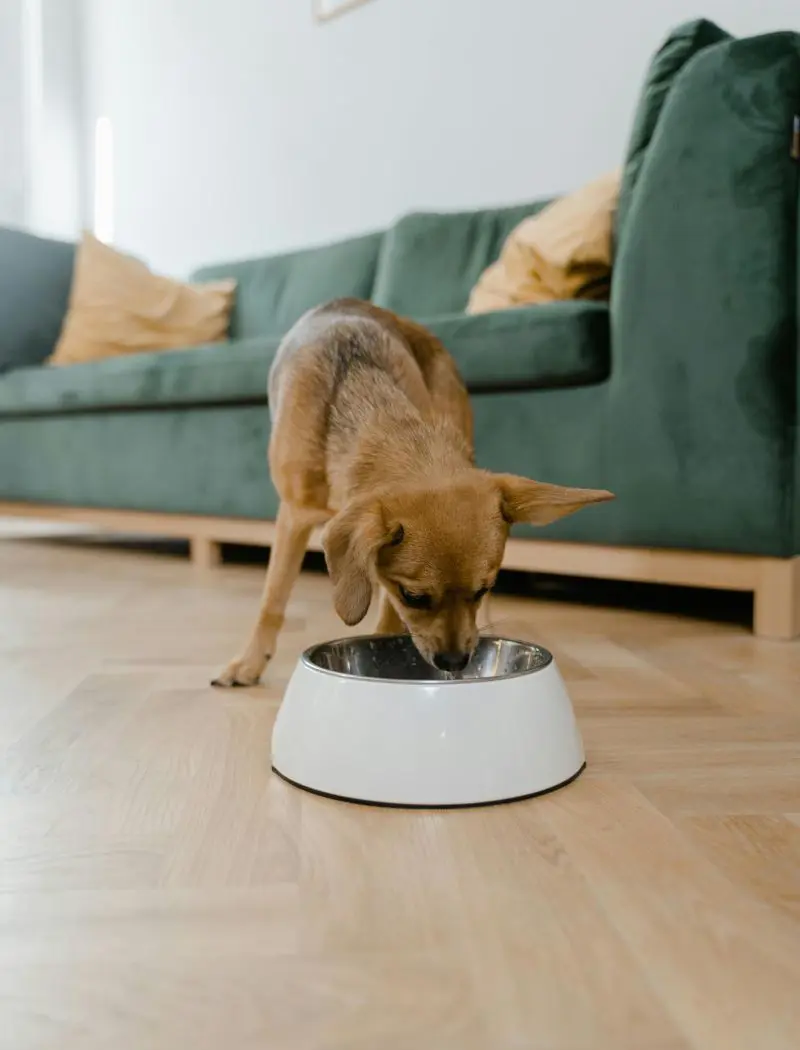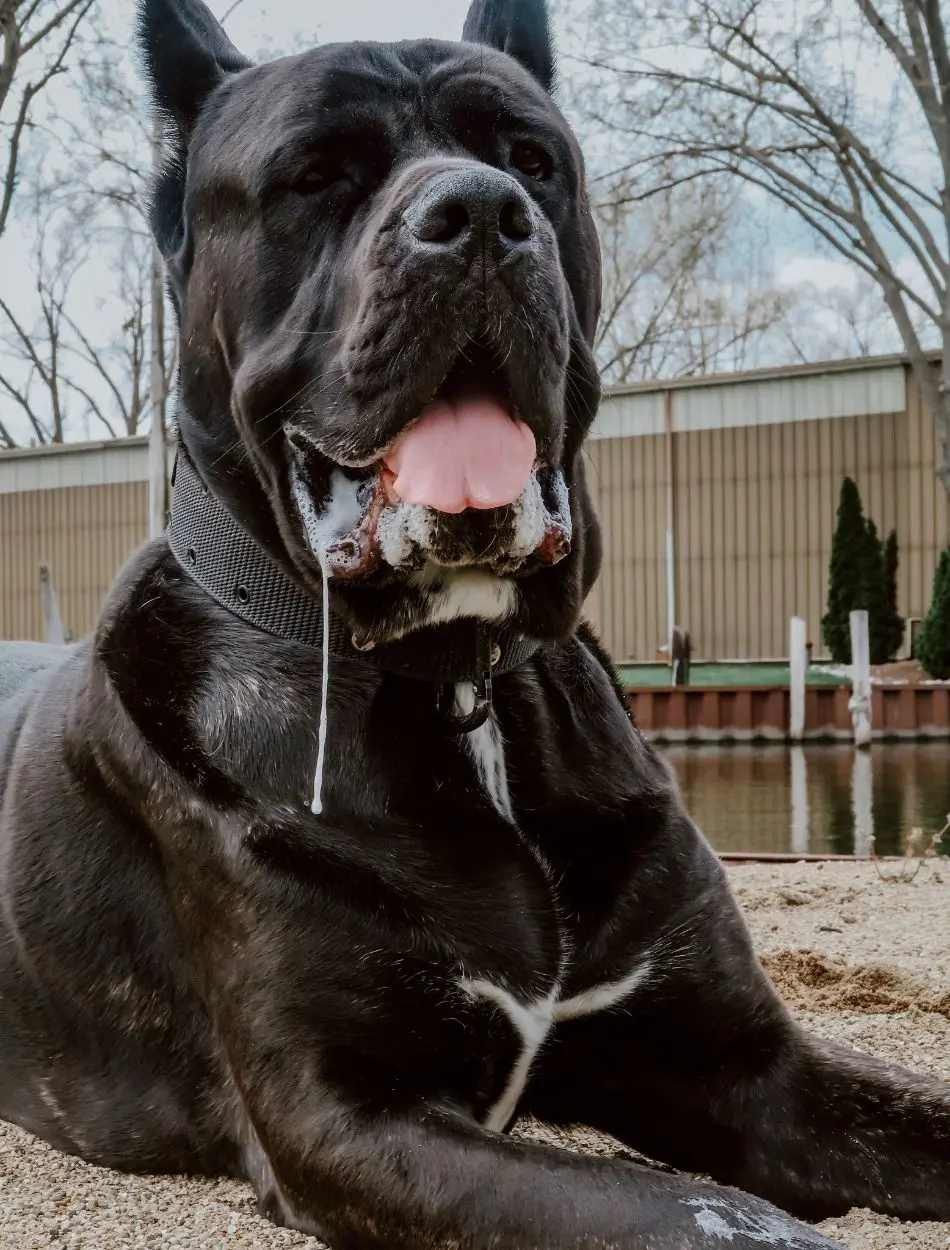17 Reasons Why Are Grapes Bad For Dogs

Whilst grapes are abundant in healthy nutrients for people, unfortunately, all colors and forms of grapes are bad for dogs. They can cause severe health complications capable of fatality in some cases.
Some dogs may experience an acute response after engrossing just a few grapes, while others may absorb more remarkable amounts without instant evident indications. This mutability in response is why it is critical to treat any ingestion as a certainly serious occurrence, regardless of the number of grapes swallowed. Prevention is the best policy to protect dogs from noxious grapes. Pet owners should keep grapes out of reach, including foods containing them, such as cereals, trail mixes, and baked goods.
1. Vomiting
Spewing is often one of the most untimely and frequent signs of grape noxiousness in dogs. When a dog consumes grapes, their body acknowledges the existence of fatal substances that need to be thrown out quickly.
Reactive vomiting is stimulated to prevent further incorporation of this damaging material into the bloodstream. This reaction commonly takes place within a few hours of ingestion and delivery as the body's instant endeavor to purify itself of the unhealthy matter found in grapes. While vomiting may help in the beginning stages by removing some harmful substances, it is not adequate to prevent the lethal effects entirely.
Constant vomiting can lead to dryness and electrolyte disparity, which further intensify the dog's state. Early interference is necessary in supervising the deadly and preventing more severe consequences.
2. Diarrhea
Dysentery is another ordinary prodrome of grape pernicious in dogs and can occur precisely after swallowing. When a dog ingests grapes, their digestive system reacts to the appearance of harmful matter by removing them as speedily as possible, often proceeding with diarrhea.
The reaction is the body's making an effort to abolish unfavourable stimulants before they can be soaked up into the bloodstream and cause further harm. While diarrhea might primarily seem like a preventive appliance, it can have a serious reaction to a dog's health. Continual diarrhea can lead to noteworthy fluid loss, causing dehydration. Dryness occurs when the body loses more fluid than it takes in, diminishing normal bodily purpose.
The mixture of dehydration and electrolyte inequality can intensify the effects of grape malignant. Induced treatment can help manage indications, prevent extreme dehydration, and turn down the risk of obstacles.
3. Lethargy

Apathy is a common indication in dogs who have swallowed grapes, throw back the untimely moment of grape unhealthyness. This condition is distinguished by a prominent decrease in energy levels, lack of interest in habitual liveliness, and overall detachment.
When a dog becomes apathetic, it often lies down more than customary, emerges tired, and may not acknowledge the commands or stimuli that would normally elicit excitement or activity. The disinterest associated with grape virulence is due to the body's response to the toxic compounds present in grapes. This harmful material can cause gastrointestinal discomfort and dehydration, foremost to a prevalent feeling of weakness and fatigue.
If a dog shows signs of inactivity after absorbing grapes or raisins, instantaneous veterinary surveillance is necessary to avert further deterioration and to provide suitable treatment.
4. Abdominal Pain
Tummy discomfort in dogs occurs if the dog swallows grapes and malignant condition of these fruits has gone about to impact the metabolishing system. This ache may be presented as whining, groaning, restlessness, or the dog embracing a bent stance to diminish irritation.
Dogs might also evade lying down or habitually modify positions in an strive to find reassurance from the ache. Stomach tenderness occurs because the toxic combination in grapes annoys the stomach lining and intestines, leading to infection. This irritation can cause cramping, bloating, and general digestive distress.
Left untreated, this pain can progress as the toxins cause more substantial disfigurement. Early interference can help relieve abdominal pain.
5. Lack Of Appetite
A lack of hunger in dogs distressed by grapes. When a dog consumes grapes, their body starts to respond to the unfavourable material present in these fruits.
This can lead to stomach upsets, including nausea and vomiting, which naturally causes less aspiration to eat. The dog's absorption system becomes swollen, and the tenderness makes eating unpleasant. Besides, as grape noxious avance, it can cause more essential effects that further drop off a dog's appetite. The collection of toxicants in bloodflow, mostly if kidney function starts to diminish, can lead to an expansion of waste products that make the dog feel unwell, further turning down the urge to eat.
The loss of palate in dogs after eating grapes is a regarding sign that suggests the body's systems are being overblown. It is decided to get veterinary care urgently if a dog shows signs of diminishing appetite following grape chug.
6. Increased Thirst

Surging thirst is a manifestation that can happen in dogs suffering from grape destructive material. When a dog swallows grapes, the harmful material present can take up to harm the urinary organ.
Exceratory organs are key organs for managing purification decay products and preserving liquid and electrolyte balance in the body. Because the noxiousness from the grapes impedes kidney function, the body may grapple to maintain these condemning balances, foremost to the extent of clues, including in escalating thirst. This rise in thirst is the body’s reply to the kidneys' eased ability to centralize urine and remove waste successfully. As a result, dogs may drink more water than regular and may also pee more repeatedly.
Early discovery and treatment are necessary to manage the toxicity and keep up the dog's health.
7. Increased Urination
If a dog shows indication of escalated excretion after absorbing grapes, it is important to look for them in the spot veterinary care. While growing urination may first help flush out some viruses, it is also a sign that the excretory organs are under pressure and could be in the rapid stages of failure.
The expanding excreting is the body's efforts to remove contaminated germs before they can cause further damage to the kidneys and other organs. Nevertheless, while this might appear like a safeguarding mechanism, it also head up to the loss of fluids and vital electrolytes, which can come to dryness and worsen the dog's condition if not properly managed.
This is the body's primary response to detoxify itself and manage the probable harm caused by the ingested grapes.
8. Dehydration
Dehydration is an important concern in dogs' misery from grape noxiousness due to a mixture of signs such as vomiting, diarrhea, and increased urination. When a dog swallows grapes, their body strives to expel the toxins through these various means.
As dryness progresses, the body loses not only water but also requires electrolytes like sodium and potassium, which are necessary for keeping normal cellular function and general fluid balance. The loss of these essential electrolytes can weaken muscle function, rattle heart rhythms, and worsen kidney outcomes, creating a ruthless cycle that further degenerates the dog's health.
Through injecting fluids and other supportive measures, a veterinarian can help reinforce the dog's condition and upgrade the chances of betterment from grape pernicious substance.
9. Weakness

Weakness in dogs is due to suffering from grape harmful particles, resulting from the combined effects of toxin exposure and dehydration. This weakness can present as difficulty standing, walking, or maintaining balance, and the dog may appear lethargic or less responsive.
The accumulation of lethality in the bloodstream, coupled with the loss of fluids and electrolytes, can result in a dog becoming weak and unsteady on its feet. The weakness indicates that the dog’s condition is worsening and may lead to more severe complications like cardiovascular issues if not treated promptly. As dehydration progresses, the dog's body loses essential minerals like sodium, potassium, and calcium, which are vital for maintaining muscle function and energy levels.
Immediate veterinary intervention is essential to provide supportive care, such as intravenous fluids and electrolyte replacement, which can help restore the dog's strength, stabilize its condition, and increase the likelihood of a full recovery.
10. Tremors
Increased excretion unsettles electrical stability across muscle and nerve cells, foremost to uncontrolled muscle contractions and tremors. These twitches may appear as shaking, vibrating, or spasms that can range from mild to severe.
Furthermore, to electrolyte disproportion, tremors may also be a result of unsafe substances affecting the nervous system. As the urinary organ fail to filter out virulent particles productively, these materials stockpile in the blood, certainly causing autonomic symptoms such as spasms, disorientation, or even seizures in extreme cases.
Tremors in dogs after grape consumption are an important sign of proceeding destructive and require instant veterinary attention. Speedy treatments, including fluid therapy and electrolyte enhancement, can help regulate the dog’s condition, prevent further neurological revamps, and improve the chances of betterment.
11. Seizures
Seizures are acute and frightening manifestations that can occur in dogs deteriorating from grape perniciousness, declaring destructive and noteworthy autonomic participation. This buildup can have comprehensive organic effects, including severe electrolyte variation and direct neurological turmoil.
Seizures are distinguished by sudden, proceeding shatter of electrical action in the brain, resulting in spasm, muscle harshness, and loss of wakefulness. In the context of grape lethality, seizures may occur due to the urinary organ's helplessness to conserve appropriate fluid and electrolyte balance, distinct levels of calcium and potassium, which are critical for normal nerve function.
Moreover, the collection of toxins in the blood can instantly affect the brain cells neurons, foremost to seizures. Existent veterinary care is indespensable to supervize seizures, strengthen the dog, and provide supportive treatments, such as hypodermic fluids and medications, to reduce contamination germ levels and support autonomic function.
12. Coma

Unconsciousness is a deprecatory and life-threatening state that can result from persistent vulnerability to contamination germs in grapes in dogs. When a dog consumes grapes, the harmful stimulant can lead to awful abdominal gland failure, which causes a hazardous spread of waste products and infection virus in the bloodflow.
An insensibility is identified by a huge state of unawareness where the dog is unresponsive to external incentives and inadequate to wake up. This serious condition is often the result of the brain being submerged by viruses and metabolic disparity, such as high levels of urea, creatinine, and other waste products.
Moreover, severe electrolyte unevenness, specifically comprising sodium and potassium, can disturb normal brain function, contributing to the progress of anesthesia. Prompt and productive medical care is critical to strive to upturn the coma and prevent irreversible brain damage.
13. Breathing Difficulty
Breathing struggles can be a major sign of dog adversity from grape noxiousness, signifying extreme systemic pain and possible obstacles affecting the respiratory system. As excretory organs fail to refine these germs efficiently, emerging metabolic disproportion can smash multiple organ systems, including the respiratory system.
Breathing trouble in dogs undergoing grape harmful material can exhibit quick or labored breathing, panting, or gasping for air. These signs may arise from multiple underlying issues, such as severe dehydration, electrolyte imbalances, or the buildup of acid in the blood (metabolic acidosis) due to nephrosis problem.
Likewise, if noxious headway affects the cardic system, it can lead to lower oxygen carriage to tissues, further intensifying breathing complication. The presence of breathingstruggling in a dog after ingesting grapes or raisins is a critical sign that it needs immediate veterinary care.
14. Fluid Cessation
Fluid cessation can occur in dogs distressed from grape noxiousness. When a dog consumes grapes, the toxic compounds can lead to acute urinary organ failure, severely harming the excretory ability to filter and excrete waste products and liquids from the body.
Fluid cessation in dogs specify that the body is maintaining fluids, leading to swelling, increased blood pressure, and possible harm to other organs. Oligura, where the dog produces very little urine, can quickly progress to unwellness, where urine production stops completely. Both conditions are serious measures of severe excretory organ defacement and a life-threatening crisis.
Remedy normally involves forceful fluid therapy to restore hydration, medications to uplift urine creation, and other helpful measures to manage fundamental excretory organ failure and stop further difficulty.
15. Hyperactivity

Hyperactivity is an uncommon but feasible indication of dog hardship from grape noxiousness, generally signifying autonomic participation. These diseases can affect neurology, causing a range of autonomic symptoms, including agitated.
Hyperactivity may be defined as imprudent anxiety, agitation, or an inability to chill out. Dogs may emerge commonly energetic, pacing, barking, or engaging in redundant attitudes. This can be due to the body's stress response to toxic exposure or a direct effect of the contamination germs on the brain.
Likewise, as urinary organs fail to purify disease successfully, there can be a disproportion of electrolytes like sodium, potassium, and calcium, which are vital for normal nerve and muscle function. This disparity can overstimulate the nervous system, leading to abnormal action or agitated.
16. Depression
Depression in dogs can be a sign of grape virulence, reflecting the effect of lethality on a dog's general health and welfare. As the excretory organs lose their capability to purify these materials helpfully, the dog may practice a range of signs, including laziness, weakness, and general malaise, all of which come up to a state of depression.
A dog showing depression due to grape noxiousness may emerge frequently quiet, withdrawn, or apathetic in its usual busyness, such as playing, eating, or cooperating with people. This lack of commitment can result from the body’s response to the physical irritation caused by signs like nausea, abdominal pain, and dehydration, or it may indicate more severe organized effects such as electrolyte disproportion and harmful virus growth affecting the brain and overall mood.
Depression in dogs following grape consumption is a regarding sign that licences speedy veterinary observation. It suggests that the dog’s condition is weakening and could lead to more severe difficulty.
17. Kidney Failure
Kidney collapse, also known as renal failure, is a serious and potentially lethal state that can result from grape perniciousness in dogs. When a dog swallows grapes, unknown unsafe compounds within these fruits can cause harm to the kidneys, foremost to critical excretory organ absortion.
The onset of kidney defeat due to grape noxiety can occur within a few hours to multiple days after eating, and signs can soar swiftly. Early signs of kidney failure include vomiting, diarrhea, lethargy, increased thirst, and increased urination. As the condition advances, the dog may show more serious signs such as reduced or no urine output, druness, loss of appetite, and weakness.
Kidney failure from grape virulent requires instant veterinary care. Induced and successful treatment is crucial to prevent irreversible kidney damage and enhance the chances of a full recovery.
Recent posts
Dogs
Why Is My Dog Panting? 18 Reasons For Breathing Fast
Dog owners, those in tune with their pets, can often notice a change in their companion’s behavior. When unwell or scared, some dogs hide while others seek solitude. Similarly, panting is a normal sign of tiredness or lethargy, but can also imp...
10 Reasons Behind Dogs Chewing And Licking Their Paws
Some of the most harmless behaviors dogs depict are chewing on their paws. But if this obsession catches onto your pup, well, that raises a couple of curious eyebrows. Your dog's tendency towards chewing and licking can affect general health and well...
18 Reasons Why Your Dog Is Not Eating
A skipped meal here or there is normal, but your dog consistently refusing food is the cause of concern. The reasons range from dietary issues to more serious health conditions and behavioral issues. The dog may be a picky eater or there might be som...
17 Causes Of Seizures In Dogs
Don't dismiss your pet dog's uncontrolled twitching movements as harmless shivering - you may be bearing witness to the classic signs of a seizure. These sudden and involuntary electrical disturbances can drastically impact a dog's health and even ch...
18 Reasons Why Your Dog Is Drooling So Much
While drooling in dogs is perfectly normal in certain situations, excessive or continued drooling may hint at a more serious issue that requires attention. Once you know the probable causes of this drooling in your dog, you can take some necessary st...
18 Reasons On Why Is My Dog Limping
A dog limping can be a cause of concern and cause stress to owners. It is not normal dog behavior and can be a sign of health problems in dogs. Understanding why your dog is limping is important to cure this problem. This article discusses 18 reasons...






